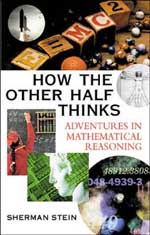'How the other half thinks'

Most people think that mathematics consists of either just arithmetic, or a collection of very abstract and technical topics which the layperson has no chance of grasping. But this really is not true: of course many areas are too technical for the non-mathematician, but there are also many beautiful and non-trivial facts which can be expressed in ordinary language for everyone to appreciate.
This is the basic premise of Sherman Stein's "How the other half thinks". Stein is from a mathematical background and is thus well prepared to appreciate both points of view. The book consists of eight chapters, each of which focuses on one particular problem, often stemming from a very simple question which might arise in everyday life. The approach he takes is that of a research mathematician. This generally consists of first experimenting around to get a feel for the problem, then tackling special cases, which often allow you to conjecture how the general case might work. Finally one finds a proof (or disproof!) of the conjecture. This is the hidden agenda of the book (or given the title perhaps not so hidden!): to show how a professional mathematician tackles difficult problems. The technicalities and abstraction, which put most people off, often come very near the end of the reasoning, and the basic key to solving the problem is often simple and elegant.
The types of problems he tackles are wideranging. We have four problems that are best fitted into the area of probability and statistics, for example finding the average length of a game, such as volleyball, where one team must finish ahead by two points to win, given that the teams are drawing one point from the end. Another problem involves finding the chance that if you drop a needle on a floor with parallel cracks, it will land crossing one of the cracks. This problem in particular is a great example of how if one generalises the initial problem its solution becomes more transparent (i.e. he argues how the shape of the needle is irrelevant and this is used to solve the initial problem). Other chapters touch on an area called analysis, basically the study of infinite sums and suchlike. Of course some of the chapters overlap in the sense that when analysing a problem in probability he finds that one needs to evaluate an infinite sum (e.g. chapter 2, the volleyball problem.) One of the chapters (chapter 3) concerns a problem in topology; relating to something called Sperner's lemma. One can also find chapters on combinatorics and one on set theory with a very nice explanation of Russell's paradox, which emerges when one starts to study sets of infinite size.
Throughout the book Stein always reduces the problem to some question about strings of two different letters. This should illustrate the power of abstract thinking to the layperson, as the problems are often quite different. Also, as a little breather, towards the end of a chapter he talks about real world applications of the results derived, which are ubiquitous in the modern world of computers and technology.
The book is well written, very pedagogical in style, and suitable for both the layperson and the mathematician. In fact as mathematicians are used to thinking about things in technical language, the layperson may even have an advantage! However it is a book which needs to be read slowly to appreciate the details of the arguments presented. In short it is a thoroughly good attempt at achieving the goal it set out to - namely to show how mathematicians think and how there are many parts of mathematics which may be appreciated by all, despite its apparent forbidding nature.
- Book details:
- How the other half thinks
- Sherman Stein
- paperback - 177 pages (2002)
- McGraw-Hill Education
- ISBN: 0071407987